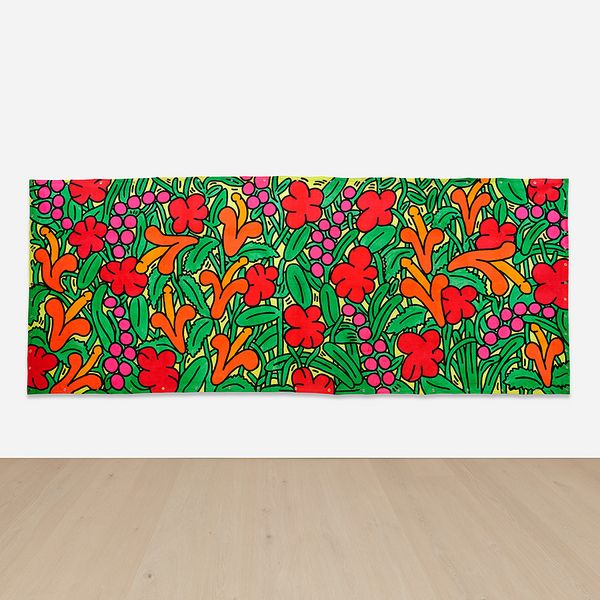Keith Haring, The Garden of Radio Delight/The Beach (double-sided), 1984. Modern & Contemporary Art: Evening & Day Sale.
Phillips’ Modern & Contemporary Art: Evening & Day Sale is on view in London at 30 Berkeley Square through 27 June, ahead of the auction at 3pm BST 27 June.
Lately, broad culture is obsessed with mixing its “high” and “low” poles. For evidence, just look to the fashion world over the past 15 years or so. Such “high x low” collaborations may be the single most impactful fashion trend of recent times — think Versace x H&M, Hermès x Apple Watch, Omega x Swatch, and all the rest. More widely, consider the pervasive approach of blending “low” and accessible brands or streetwear with high fashion within a single outfit. One could argue that there is no longer a distinction between the two, in fashion or elsewhere in culture.
But this notion extends beyond what we wear and how we present ourselves, applying to the food we eat and the culture we explore through books, music, film, art, and more. It also applies to the lifestyles of artists themselves. Andy Warhol’s adoration of McDonalds, for example, would have been seen as a bit eccentric at the time, an era when we would have expected a priest of high culture to live a refined life. In our own time, this is completely normalized. Consider the American writer and chef Anthony Bourdain, who was known to speak of the greasy “animal-style” cheeseburgers of the famed Californian eatery In-and-Out with as much adoration and respect as he did the haute cuisine of the nearby French Laundry. Or Pulitzer Prize-winning composer Caroline Shaw, who has expressed taking influence from pop music as much as Renaissance and Baroque choral music or contemporary composers. She’s even appeared in the campy Amazon Prime television show Mozart in the Jungle.
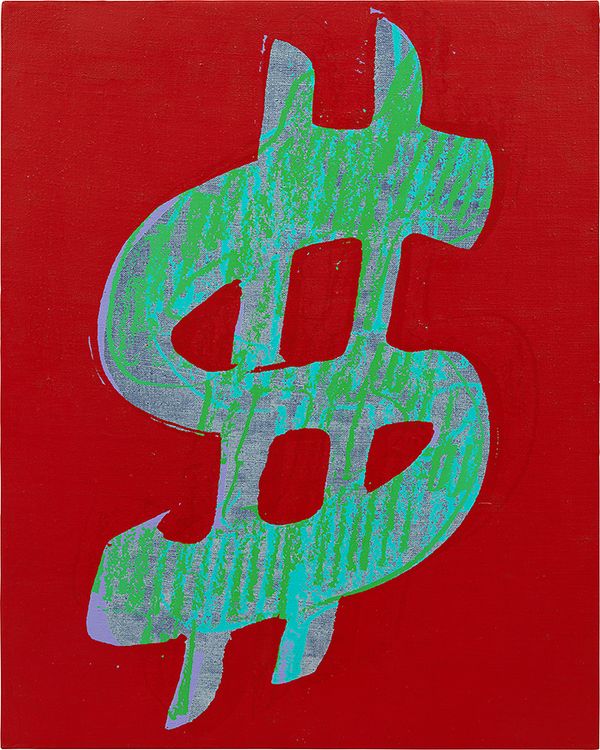
Andy Warhol, Dollar Sign, 1981. Modern & Contemporary Art: Evening & Day Sale.
An idea that can perhaps explain this cultural phenomenon is one that Andy Warhol understood well: that as information becomes more readily accessible, it also becomes less valuable, less rare. Warhol’s visual exploration of this notion resulted in the blurring of lines between high and low culture that are now nearly entirely erased. Today, so-called “high” art may no longer be the exclusive domain of the well-educated, as the proliferation of media covering such topics — ranging from free articles on the internet to books purchased online and documentary films streamed at low cost — make ideas less exclusive to those with special access, because everyone has access. Even further, the notion of Warholian celebrity abounds today online, owned by any individual on whichever platform they choose to express their personal mix of high and low cultural sensibilities. Indeed, the fifteen minutes of fame Warhol predicted we would all experience one day has arrived in a blink.
To understand how we may have gotten here, let’s count backwards. Today, it’s estimated that 66% of the world’s population uses the internet daily — nearly five and a half billion people. In 1995, that number was just 16 million. But it was only in 1993 that the world wide web was first readily accessible for home use. Just three years prior, in 1990, the world lost Keith Haring at a tragically young age, and in 1988, Jean-Michel Basquiat. Only one year before, Andy Warhol died, and the year before that — 1986 — Warhol created Campbell’s Soup, revisiting the image of “low” culture expressed as fine art that enthralled viewers and launched his career in the 1960s.
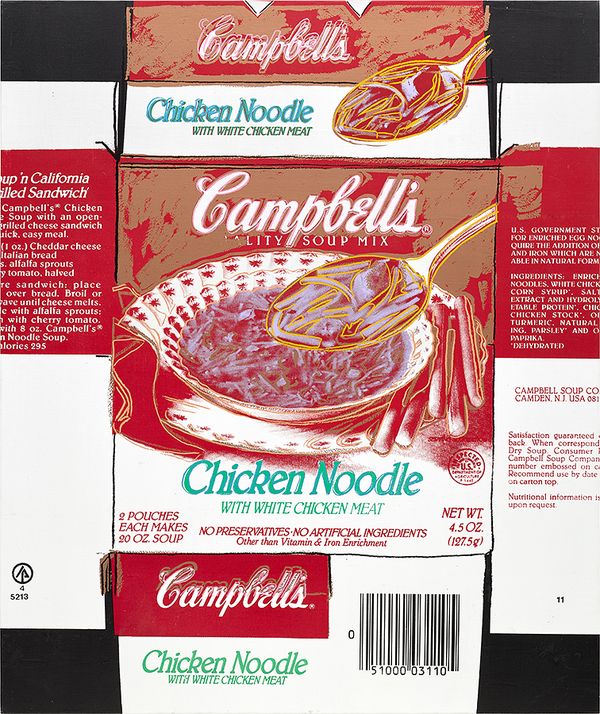
Andy Warhol, Campbell's Soup, 1986. Modern & Contemporary Art: Evening & Day Sale.
Warhol and the artists he influenced — including Keith Haring — proved the power of popular symbols and icons through appropriation, transposing them into the realm of high art. From the magazines where he started his career as a commercial illustrator to his unique understanding of the pervasive influence of television advertising and the expansion of celebrity culture, Warhol recognized that the rise of mass media in the 20th century would upend the old rules policing culture. Instead, impact, celebrity, or the sheer pervasiveness of an image or an idea would be the fuel that powers culture. Utilizing imagery that had been burned in the mind’s eye of mass culture — soup cans, dollar signs, celebrities, toys, and more — Warhol gave these images iconic status, as culturally valuable as Ancient Greek architecture, Egyptian pyramids, or any other symbol of a civilization. In a sense, by embracing mass culture as inherently positive, he turned a mirror on society, giving us an opportunity to consider our reflection and the post-war values it represents. It was Warhol’s genius to recognize this as the crux of new media, and perhaps predict where it would take us. After all, the evolved internet we now interact with every day functions like a personalized mirror, a practice that proves just how much culture loves to look at itself.

Left: Andy Warhol, Marilyn Monroe (Marilyn), circa 1978. Right: Andy Warhol, Panda Drummer (Toy Series), 1983. Modern & Contemporary Art: Evening & Day Sale.
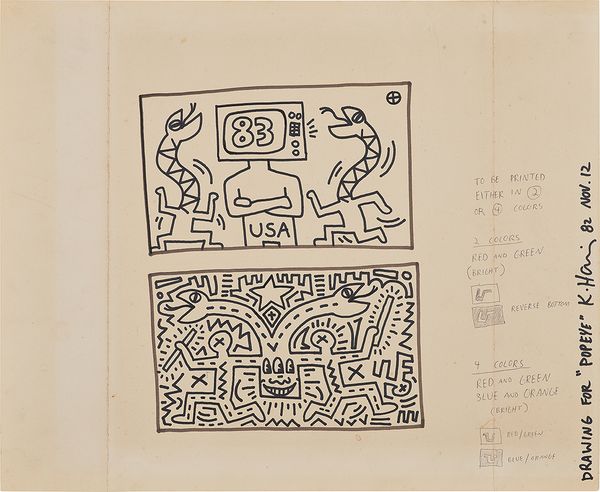
Keith Haring, Untitled (Drawing for "Popeye"), 1982. Modern & Contemporary Art: Evening & Day Sale.
For Keith Haring, whose world included the emerging media genres of hip-hop, street art, cable television, and the devastating crack and AIDS epidemics, Warhol’s example was crucial. Haring engaged with mass culture by making his work accessible, viewable on subway cars and available in the Pop Shop retail store, which also functioned as a work of performance art. His art’s accessibility to everyone in an age of information overload didn’t devalue Haring’s work, it made it more valued by more people. This is also a testament to Haring’s ability to remain plugged-in to his culture at both ends, as Choreographer Bill T. Jones — who Keith Haring collaborated with for the set design on offer here — remarked that Keith Haring “was very much a part of club culture, of high and low, that mix, which was the 1980s.”
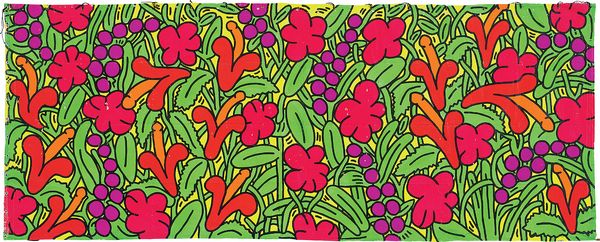
Keith Haring, The Garden of Radio Delight/The Beach (double-sided), 1984. Modern & Contemporary Art: Evening & Day Sale.

Keith Haring, The Garden of Radio Delight/The Beach (double-sided), 1984. Modern & Contemporary Art: Evening & Day Sale.
One could criticize these cultural evolutions, and many do, particularly as rumors swirl that younger generations may see more value in cultivating an internet persona than attending college — one’s follower count (and the all too important followers to following ratio) ringing as more prized that one’s ideas. But look at the artists in this upcoming auction who were born in 1990 or later: Michaela Yearwood-Dan, Alfie Caine, Vojtěch Kovařík, Wynnie Mynerva, Flora Yukhnovich, Jadé Fadojutimi, and Elman Mansimov.
These artists were born just as Warhol, Haring, and Basquiat passed, and just as the internet exponentially expanded the forces that initially inspired the first wave of Pop Art. One marvels at the fact that these artists’ minds blossomed in an era when information about art and culture was so widely available, regardless of their location or socioeconomic status. To look at the depth and variety of their work today provides hope. We can see that as creators or collectors, from the high to the low, it’s all out there to consider if you know what to look for and how to let it find you. And it’s never been more rewarding or more personal to take from such accessible information and dream. That’s not “high” or “low” in value, it’s just empowering.
Discover More from Modern & Contemporary Art >
Recommended Reading
Ancient Symbols, Modern Icons >
